Shades of Gray: The Legend of Korra
- ogradyfilm
- Jan 13, 2019
- 2 min read

The central conflict of Nickelodeon’s The Legend of Korra has been anything but black-and-white. In “The Revelation,” series antagonist and Equalist leader Amon demonstrated his potential to become the very sort of oppressive force he claims to oppose. In “The Aftermath,” we learned that not all Equalists fight to tear down the corrupt elite: Hiroshi Sato, one of Republic City’s most successful businessmen and a noted non-bender, wants to punish all benders—including “street rats” like Mako and Bolin—for the murder of his wife.
And in the most recent episode, “When Extremes Meet,” Councilman Tarrlok, previously little more than a vain, overly ambitious nuisance, reveals that he’s just as cunning, manipulative, and dangerous as Amon—perhaps even more so.

Using Chief Lin Beifong’s departure from the police force to increase his own political influence, Tarrlok pushes the city toward martial law, punishing all non-benders for the sins of a few (not unlike Amon, as Korra points out). This dramatic turn of events changes the shape of the show’s overarching conflict. The Legend of Korra is no longer just about an anti-bending revolution; it’s about a world thrown into chaos, caught between two extremes.
Like Aang before her, Korra must fulfill her duty as the Avatar and restore balance—but in this cycle, that’s not as simple as taking down a single megalomaniac. Tarrlok and Amon make questionable ethical choices (and likely have ulterior motives), but their supporters raise valid concerns. The benders of Republic City have good reason to fear a man capable of stripping them of their natural talents (which, in many cases, they depend on to make a living). The non-benders, on the other hand, truly are powerless against any bender that chooses to abuse his authority, as Tarrlok and Saikhan clearly demonstrate in “When Extremes Meet.” Both sides employ inherently flawed methods (tyranny and terrorism), but we recognize the basic needs and desires that drove them to such extreme measures. Thus, the distinctions between right and wrong, good and evil, black and white gradually dissolve, leaving the viewer with only a burning question: “How can one person possibly fix this mess?”

Not many all-ages cartoons challenge the audience with such authentic moral complexity.
[Originally written June 4, 2012.]





Comments